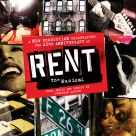They were written a century apart, but Opera classic LA BOHEME and Musical Theatre groundbreaker RENT have more in common than you might think. In fact, RENT was actually based on Puccini's Italian masterpiece. Lauryn Clarke - from our friends at the Musical Theatre Appreciation Society - delves into the differences and similarities between the two shows...
Performed for the first time 100 years apart, in a different language and in a different art form, at first glance everything about these two shows seems different, but when you look closer there are a lot of similarities between Jonathan Larson's RENT and Giacomo Puccini's LA BOHEME. I was lucky enough to have seen both the Welsh National Opera’s tour of LA BOHEME and the 20th anniversary National UK Tour of RENT recently and when thinking about them, noticed some interesting similarities as well as differences which I will talk about in this article, but be warned, spoilers ahead!
Let’s start with the most obvious – the time period. In his first and only newspaper interview, Jonathan Larson (who wrote the show but tragically died before it opened) noted that the opening of RENT off-Broadway would be on 1st February 1996 which was the 100th anniversary of the first performance of LA BOHEME in Turin, Italy. Although the time period clearly influences each of the pieces, it doesn’t obstruct from certain plot points or themes being present in both such as friendship and love, life and death, work and rent.

This is one of the areas where you can clearly see the elements Larson took inspiration from, as well as what he changed to fit his musical. There are the same amount of main characters and most of them are the same gender apart from Joanne who is based on Alcindoro but also slightly on Marcello who are both men.
As Joanne is a mix of two characters it is obvious that her outcome in the end of RENT will be different to that of the two characters in LA BOHEME – whereas at the end of RENT Joanne is in a relationship with Maureen, at the end of LA BOHEME it is Marcello and Musetta (Mark and Maureen’s predecessors) who end the opera in a relationship.
Mimi is the character who is most like her predecessor, with the same name and near enough the same plot throughout both pieces, although one defining difference is that unlike in RENT, Mimi does indeed die at the end of LA BOHEME. Other than Joanne, the rest of the characters in RENT have names that start with the same letter or are otherwise similar to the opera as shown below:
Rodolfo=Roger
Marcello=Mark
Schaunard=Angel Dumott Schunard
Colline=Tom Collins
Musetta=Maureen
Benoît=Benny

Bringing back the century-long time difference, some of the characters obviously have a difference in career. Marcello is a painter in LA BOHEME but when updating it for 1990s audience, Larson changed Mark to a filmmaker which would arguably more relatable for the audience of the time. Some of the characters are similar in occupation such as Colline being a philosopher and Benoît being their landlord with the only large difference being the difference in Mimi from a seamstress to an exotic dancer.
Again due Larson’s updating of the opera for a modern, New York audience, the disease tuberculosis of which Mimi dies in LA BOHEME is changed to HIV/AIDS. This is one of the areas where it is clear RENT is only loosely based on LA BOHEME due to its portrayal of the AIDS crisis of the 1980s/90s – in RENT, not only Mimi but also Roger, Collins and Angel are HIV+ whereas in LA BOHEME only Mimi becomes sick.
But the most important similarity of all…How much the audiences enjoyed it!
With every performance I went to, everyone seemed to enjoy themselves which is the most important part! I talked to people at both shows and everyone was happy which truly shows the magic of theatre – that no matter what the piece is, whatever style or wherever it is, people are brought together by a show!


